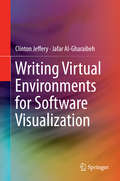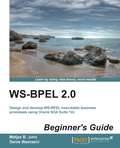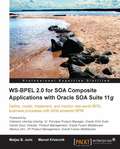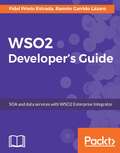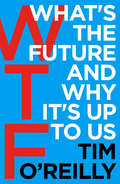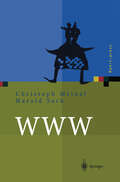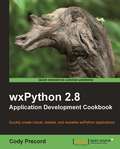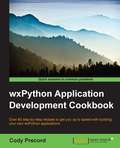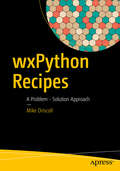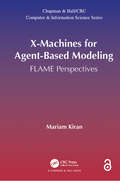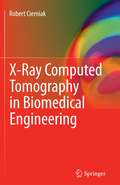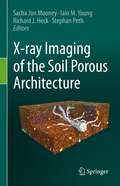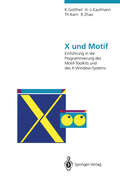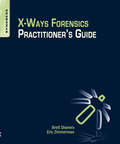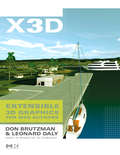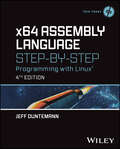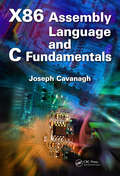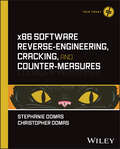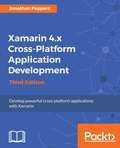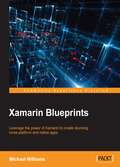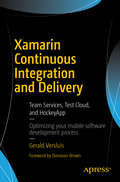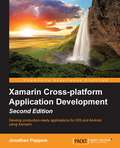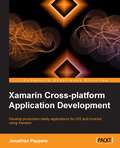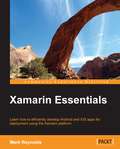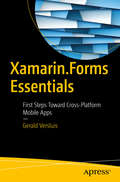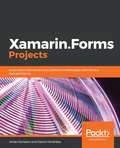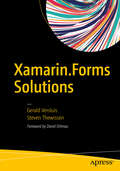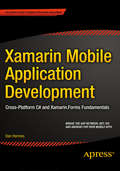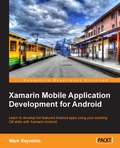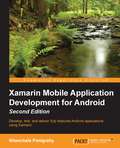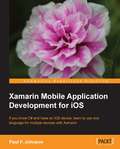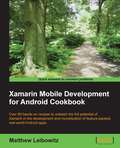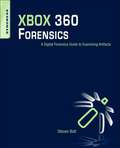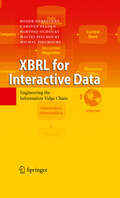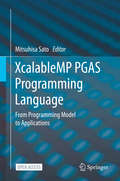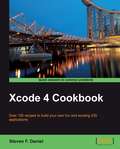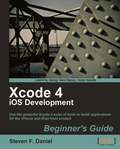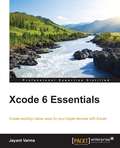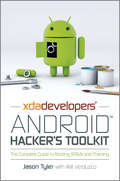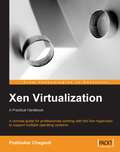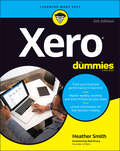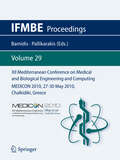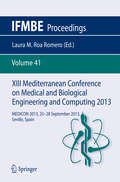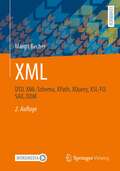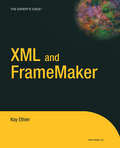- Table View
- List View
Writing Virtual Environments for Software Visualization
by Clinton Jeffery Jafar Al-GharaibehWriting Virtual Environments for Software Visualization book describes the software for a networked, 3D multi-user virtual environment that allows users to create and share remotely visualizations of program behavior. Collaborative virtual environments such as World of Warcraft or Second Life are a popular way to share interactive internet experiences, but they are complex and difficult to create. Software visualization is an area that may enable important advances in our ability to understand and reduce the costs of maintaining software. Applying the former technology to this problem area will be valuable to distributed and multi-institutional software development and educational users. The author covers the major features of collaborative virtual environments and how to program them in a very high level language. The book also examines the application of popular game-like software technologies.
WS-BPEL 2.0 Beginner's Guide
by Matjaz B. Juric Denis WeerasiriIf you are a software architect, a designer, a software developer, an SOA and BPM architect, a project manager, or a business process analyst who is responsible for the design and development of business processes, composite applications, and BPM/SOA solutions, then this book is for you. You should have a clear grasp of general SOA concepts including business processes and web services, but no prior knowledge of the BPEL language is required.
WS-BPEL 2.0 for SOA Composite Applications with Oracle SOA Suite 11g
by Matjaz B. Juric Marcel KrizevnikThis book is a comprehensive guide that shows developers how to design and develop business processes in BPEL efficiently. Throughout the book, the authors discuss important concepts and show real-world examples covering Oracle SOA Suite 11g and related products. This book is aimed at SOA architects and developers involved in the design, implementation, and integration of composite applications and end-to-end business processes. The book provides comprehensive coverage of WS-BPEL 2.0 for implementing business processes and developing SCA composite application, dealing with the issues of composition, orchestration, transactions, coordination, and security. This book uses Oracle SOA Suite 11g and related Oracle products. To follow this book you need to have basic knowledge of XML, web services, and Java EE.
WSO2 Developer's Guide: SOA and data services with WSO2 Enterprise Integrator
by Fidel Prieto Estrada Ramon Garrido LazaroWSO2 Made Simple – dive deep into the core concepts of WSO2 to overcome the challenges faced while using the Enterprise Integrator About This Book • Design, create, and publish services in the WSO2 technology • Integrate the WSO2 Enterprise Integrator with other components and servers • Log and test deployed services Who This Book Is For If you are a Java solutions architect or developer and are keen to understand how to build enterprise applications with WSO2, this book is for you. No prior knowledge of WSO2 is expected. What You Will Learn • Configure WSO2 Enterprise Integrator server in a production environment • Create SOAP Proxies and REST APIs • Interact with WSO2 Message Broker • Write services using the new language: Ballerina • Schedule automatic tasks for the services you create • Manage log messages depending on the log level of the system • Integrate with social networks such as Twitter, Facebook, Instagram, and Yammer • Test SOAP Services using the Tryit feature and SoapUI tool • Work with Quality of Services In Detail WSO2 Enterprise Integrator brings together the most powerful servers provided by the WSO2 company for your SOA infrastructure. As an Enterprise Service Bus (ESB), WSO2 Enterprise Integrator provides greater flexibility and agility to meet growing enterprise demands, whereas, as a Data Services Server (DSS), it provides an easy-to-use platform for integrating data stores, creating composite views across different data sources, and hosting data services. Using real-world scenarios, this book helps you build a solid foundation in developing enterprise applications with powerful data integration capabilities using the WSO2 servers. The book gets you started by brushing up your knowledge about SOA architecture and how it can be implemented through WSO2. It will help build your expertise with the core concepts of ESB such as building proxies, sequences, endpoints, and how to work with these in WSO2. Going further, you will also get well-acquainted with DSS data service concepts such as configuring data services, tasks, events, testing, and much more. The book will also cover API management techniques. Along with ESB and DSS, you will also learn about business process servers, the rules server and other components that together provide the control and robustness your enterprise applications will need. With practical use cases, the book covers typical daily scenarios you will come across while using these servers to give you hands-on experience. Style and approach The book is a complete guide and helps you get the right start—from understanding SOA architectures to getting valuable experience with two important integration servers such as ESB and DSS. It will include some real-world practical scenarios to help you master the best practices followed right across the industry and overcome the challenges you're likely to face on a daily basis.
WTF?: What's the Future and Why It's Up to Us
by Tim O'Reilly‘The man who can really make a whole industry happen.’ Eric Schmidt, Executive Chairman of Google‘A punchy and provocative book . . . WTF? is an insightful and heartfelt plea, daring us to reimagine a better economy and society.’ Financial TimesRenowned as ‘the Oracle of Silicon Valley’, Tim O’Reilly has spent three decades exploring the world-transforming power of information technology. Now, the leading thinker of the internet age turns his eye to the future – and asks the questions that will frame the next stage of the digital revolution:· Will increased automation destroy jobs or create new opportunities?· What will the company of tomorrow look like?· Is a world dominated by algorithms to be welcomed or feared?· How can we ensure that technology serves people, rather than the other way around?· How can we all become better at mapping future trends?Tim O’Reilly’s insights create an authoritative, compelling and often surprising portrait of the world we will soon inhabit, highlighting both the many pitfalls and the enormous opportunities that lie ahead.‘Tim O’Reilly has been at the cutting edge of the internet since it went commercial.’ New York Times‘O’Reilly’s ability to quickly identify nascent trends is unparalleled.’ Wired
WWW: Kommunikation, Internetworking, Web-Technologien (Xpert.press)
by Christoph Meinel Harald SackDieses Handbuch bietet für alle Nutzer und Entwickler des World Wide Web einen fundierten Einblick in dessen Aufbau und Funktionsweise. Die Autoren stellen die Internet-Technologie ausführlich dar und geben einen umfassenden Überblick über die relevanten Teilbereiche des WWW. Neben den allgemeinen theoretischen und praktischen Grundlagen der Netzwerktechnik und einer Darstellung der TCP/IP-Protokolle werden auch die vielfältigen Medientypen und deren Kodierung im WWW erläutert. Darauf aufbauend wird auf spezielle Web-Technologien im WWW wie HTTP, HTML, CSS, XML/XSL aber auch Skriptsprachen und CGI-Programmierung eingegangen. Dabei werden die allgemeinverständlich angelegten Kapitel punktuell durch relevante Schwerpunktthemen technischer Natur ergänzt und vertieft. Zahlreiche Abbildungen sowie Index und Glossar zu jedem Kapitel erhöhen den praktischen Nutzen des Handbuchs.
wxPython 2.8 Application Development Cookbook
by Cody PrecordWritten in cookbook style, this book offers learning and techniques through recipes. It contains step-by-step instructions for developers who want to build feature-rich desktop applications in wxPython. The book is designed in such a way that you can refer to things chapter by chapter, and read them in no particular order. This book is written for python programmers wanting to develop GUI applications. Basic knowledge of Python is required.
wxPython Application Development Cookbook
by Cody PrecordOver 80 step-by-step recipes to get you up to speed with building your own wxPython applications About This Book • This book empowers you to create rich cross-platform graphical user interfaces using Python • It helps you develop applications that can be deployed on Windows, OSX, and Linux • The recipes in the book involve real-world applications, giving you a first-hand experience of the practical scenarios Who This Book Is For For those who are familiar with programming in Python and want to start building applications with graphical user interfaces, this book will get you up and running quickly. A basic understanding of the Python programming language and object-oriented concepts are all that is needed. What You Will Learn • Create full featured user interfaces • Design and develop custom controls • Deploy and distribute wxPython applications to Windows, Macintosh OS X, Linux, and other UNIX-like environments • Handle and respond to application events • Manage and display data using grids • Interact with web services from your GUI • Use Paint events to draw custom displays • Support the display of user interfaces in multiple languages In Detail wxPython is a GUI toolkit for the Python programming language built on top of the cross-platform wxWidgets GUI libraries. wxPython provides a powerful set of tools that allow you to quickly and efficiently building applications that can run on a variety of different platforms. Since wxWidgets provides a wrapper around each platform's native GUI toolkit, the applications built with wxPython will have a native look and feel wherever they are deployed. This book will provide you with the skills to build highly functional and native looking user interfaces for Python applications on multiple operating system environments. By working through the recipes, you will gain insights into and exposure to creating applications using wxPython. With a wide range of topics covered in the book, there are recipes to get the most basic of beginners started in GUI programming as well as tips to help experienced users get more out of their applications. The recipes will take you from the most basic application constructs all the way through to the deployment of complete applications. Style and approach This book is a collection of step-by-step recipes that introduce the various components and concepts of wxPython in a conversational and easy-to-follow way. Each recipe contains coded examples along with detailed explanations about the key points of each topic. Each topic is designed to introduce and show you how to use a single feature from the wxPython library.
wxPython Recipes: A Problem - Solution Approach
by Mike DriscollQuickly discover solutions to common problems, learn best practices, and understand everything wxPython has to offer. This book is for anyone wanting to learn more about how to use the wxPython desktop GUI toolkit. It assumes some prior knowledge of Python and a general understanding of wxPython or GUI development, and contains more than 50 recipes covering various tasks and aspects of the toolkit.wxPython Recipes guides you step by step. The book takes you through how to create user interfaces in Python, including adding widgets, changing background images, manipulating dialogs, managing data, and much more. Examples target both Python 2.x and 3.x, and cover both wxPython 3.0 and Phoenix, offering a complete collection of ideas to improve your GUI development.What You'll LearnWork with UI elements such as widgets, buttons, images, boxes, and moreHandle data in files and notebooksImplement XML and using XML resources (XRC)Customize the behavior of panels and objects Who This Book Is ForPeople who are already familiar with the Python programming language and also have a basic understanding of wxPython. Readers who understand event loops and the basics of creating user interfaces with another Python UI toolkit, such as Tkinter or PyQt.
X-Machines for Agent-Based Modeling: FLAME Perspectives (Chapman & Hall/CRC Computer and Information Science Series)
by Mariam KiranFrom the Foreword: "This book exemplifies one of the most successful approaches to modeling and simulating [the] new generation of complex systems. FLAME was designed to make the building of large scale complex systems models straightforward and the simulation code that it generates is highly efficient and can be run on any modern technology. FLAME was the first such platform that ran efficiently on high performance parallel computers and a version for GPU technology is also available. At its heart, and the reason why it is so efficient and robust, is the use of a powerful computational model ‘Communicating X-machines’ which is general enough to cope with most types of modelling problems. As well as being increasingly important in academic research, FLAME is now being applied in industry in many different application areas. This book describes the basics of FLAME and is illustrated with numerous examples."—Professor Mike Holcombe, University of Sheffield, UK Agent-based models have shown applications in various fields such as biology, economics, and social science. Over the years, multiple agent-based modeling frameworks have been produced, allowing experts with non-computing background to easily write and simulate their models. However, most of these models are limited by the capability of the framework, the time it takes for a simulation to finish, or how to handle the massive amounts of data produced. FLAME (Flexible Large-scale Agent-based Modeling Environment) was produced and developed through the years to address these issues. This book contains a comprehensive summary of the field, covers the basics of FLAME, and shows how concepts of X-machines, can be stretched across multiple fields to produce agent models. It has been written with several audiences in mind. First, it is organized as a collection of models, with detailed descriptions of how models can be designed, especially for beginners. A number of theoretical aspects of software engineering and how they relate to agent-based models are discussed for students interested in software engineering and parallel computing. Finally, it is intended as a guide to developers from biology, economics, and social science, who want to explore how to write agent-based models for their research area. By working through the model examples provided, anyone should be able to design and build agent-based models and deploy them. With FLAME, they can easily increase the agent number and run models on parallel computers, in order to save on simulation complexity and waiting time for results. Because the field is so large and active, the book does not aim to cover all aspects of agent-based modeling and its research challenges. The models are presented to show researchers how they can build complex agent functions for their models. The book demonstrates the advantage of using agent-based models in simulation experiments, providing a case to move away from differential equations and build more reliable, close to real, models. The Open Access version of this book, available at https://doi.org/10.1201/9781315370729, has been made available under a Creative Commons Attribution-Non Commercial-No Derivatives 4.0 license.
X-Machines for Agent-Based Modeling: FLAME Perspectives (Chapman & Hall/CRC Computer and Information Science Series)
by Mariam KiranFrom the Foreword: "This book exemplifies one of the most successful approaches to modeling and simulating [the] new generation of complex systems. FLAME was designed to make the building of large scale complex systems models straightforward and the simulation code that it generates is highly efficient and can be run on any modern technology. FLAME was the first such platform that ran efficiently on high performance parallel computers and a version for GPU technology is also available. At its heart, and the reason why it is so efficient and robust, is the use of a powerful computational model ‘Communicating X-machines’ which is general enough to cope with most types of modelling problems. As well as being increasingly important in academic research, FLAME is now being applied in industry in many different application areas. This book describes the basics of FLAME and is illustrated with numerous examples."—Professor Mike Holcombe, University of Sheffield, UK Agent-based models have shown applications in various fields such as biology, economics, and social science. Over the years, multiple agent-based modeling frameworks have been produced, allowing experts with non-computing background to easily write and simulate their models. However, most of these models are limited by the capability of the framework, the time it takes for a simulation to finish, or how to handle the massive amounts of data produced. FLAME (Flexible Large-scale Agent-based Modeling Environment) was produced and developed through the years to address these issues. This book contains a comprehensive summary of the field, covers the basics of FLAME, and shows how concepts of X-machines, can be stretched across multiple fields to produce agent models. It has been written with several audiences in mind. First, it is organized as a collection of models, with detailed descriptions of how models can be designed, especially for beginners. A number of theoretical aspects of software engineering and how they relate to agent-based models are discussed for students interested in software engineering and parallel computing. Finally, it is intended as a guide to developers from biology, economics, and social science, who want to explore how to write agent-based models for their research area. By working through the model examples provided, anyone should be able to design and build agent-based models and deploy them. With FLAME, they can easily increase the agent number and run models on parallel computers, in order to save on simulation complexity and waiting time for results. Because the field is so large and active, the book does not aim to cover all aspects of agent-based modeling and its research challenges. The models are presented to show researchers how they can build complex agent functions for their models. The book demonstrates the advantage of using agent-based models in simulation experiments, providing a case to move away from differential equations and build more reliable, close to real, models. The Open Access version of this book, available at https://doi.org/10.1201/9781315370729, has been made available under a Creative Commons Attribution-Non Commercial-No Derivatives 4.0 license.
X-Ray Computed Tomography in Biomedical Engineering
by Robert CierniakComputed Tomography gives a detailed overview of various aspects of computed tomography. It discusses X-ray CT tomography from a historical point of view, the design and physical operating principles of computed tomography apparatus, the algorithms of image reconstruction and the quality assessment criteria of tomography scanners. Algorithms of image reconstruction from projections, a crucial problem in medical imaging, are considered in depth. The author gives descriptions of the reconstruction methods related to tomography scanners with a parallel X-ray beam, trough solutions with fan-shaped beam and successive modifications of spiral scanners. Computed Tomography contains a dedicated chapter for those readers who are interested in computer simulations based on studies of reconstruction algorithms. The information included in this chapter will enable readers to create a simulation environment in which virtual tomography projections can be obtained in all basic projection systems. This monograph is a valuable study on computed tomography that will be of interest to advanced students and researchers in the fields of biomedical engineering, medical electronics, computer science and medicine.
X-ray Imaging of the Soil Porous Architecture
by Sacha Jon Mooney Iain M. Young Richard J. Heck Stephan PethThe advent of X-ray Computed Tomography (CT) as a tool for the soil sciences almost 40 years ago has revolutionised the field. Soil is the fragile, thin layer of material that exists above earth’s geological substrates upon which so much of life on earth depends. However a major limitation to our understanding of how soils behave and function is due to its complex, opaque structure that hinders our ability to assess its porous architecture without disturbance. X-ray imagery has facilitated the ability to truly observe soil as it exists in three dimensions and across contrasting spatial and temporal scales in the field in an undisturbed fashion. This book gives a comprehensive overview of the “state of the art” in a variety of application areas where this type of imaging is used, including soil water physics and hydrology, agronomic management of soils, and soil-plant-microbe interactions. It provides the necessary details for entry level readers in the crucial areas of sample preparation, scanner optimisation and image processing and analysis. Drawing on experts across the globe, from both academia and industry, the book covers the necessary “dos and don’ts”, but also offers insights into the future of both technology and science. The wider application of the book is provided by dedicated chapters on how the data from such imagery can be incorporated into models and how the technology can be interfaced with other relevant technical applications. The book ends with a future outlook from the four editors, each of whom has over 20 years of experience in the application of X-ray CT to soil science.
X und Motif: Einführung in die Programmierung des Motif-Toolkits und des X-Window-Systems
by Klaus Gottheil Hermann-Josef Kaufmann Thomas Kern Rui ZhaoX-Ways Forensics Practitioner’s Guide
by Eric Zimmerman Brett ShaversThe X-Ways Forensics Practitioner's Guide is more than a manual-it's a complete reference guide to the full use of one of the most powerful forensic applications available, software that is used by a wide array of law enforcement agencies and private forensic examiners on a daily basis. In the X-Ways Forensics Practitioner's Guide, the authors provide you with complete coverage of this powerful tool, walking you through configuration and X-Ways fundamentals, and then moving through case flow, creating and importing hash databases, digging into OS artifacts, and conducting searches. With X-Ways Forensics Practitioner's Guide, you will be able to use X-Ways Forensics to its fullest potential without any additional training. The book takes you from installation to the most advanced features of the software. Once you are familiar with the basic components of X-Ways, the authors demonstrate never-before-documented features using real life examples and information on how to present investigation results. The book culminates with chapters on reporting, triage and preview methods, as well as electronic discovery and cool X-Ways apps.Provides detailed explanations of the complete forensic investigation processe using X-Ways Forensics.Goes beyond the basics: hands-on case demonstrations of never-before-documented features of X-Ways.Provides the best resource of hands-on information to use X-Ways Forensics.
X3D: Extensible 3D Graphics for Web Authors (The Morgan Kaufmann Series in Computer Graphics)
by Don Brutzman Leonard DalyIn the early days of the Web a need was recognized for a language to display 3D objects through a browser. An HTML-like language, VRML, was proposed in 1994 and became the standard for describing interactive 3D objects and worlds on the Web. 3D Web courses were started, several best-selling books were published, and VRML continues to be used today. However VRML, because it was based on HTML, is a stodgy language that is not easy to incorporate with other applications and has been difficult to add features to. Meanwhile, applications for interactive 3D graphics have been exploding in areas such as medicine, science, industry, and entertainment. There is a strong need for a set of modern Web-based technologies, applied within a standard extensible framework, to enable a new generation of modeling & simulation applications to emerge, develop, and interoperate. X3D is the next generation open standard for 3D on the web. It is the result of several years of development by the Web 3D Consortium's X3D Task Group. Instead of a large monolithic specification (like VRML), which requires full adoption for compliance, X3D is a component-based architecture that can support applications ranging from a simple non-interactive animation to the latest streaming or rendering applications. X3D replaces VRML, but also provides compatibility with existing VRML content and browsers. Don Brutzman organized the first symposium on VRML and is playing a similar role with X3D; he is a founding member of the consortium. Len Daly is a professional member of the consortium and both Len and Don have been involved with the development of the standard from the start.The first book on the new way to present interactive 3D content over the Web, written by two of the designers of the standardPlentiful illustrations and screen shots in the full color textCompanion website with extensive content, including the X3D specification, sample code and applications, content creation tools, and demos of compatible Web browsers
x64 Assembly Language Step-by-Step: Programming with Linux (Tech Today)
by Jeff DuntemannThe long-awaited x64 edition of the bestselling introduction to Intel assembly language In the newly revised fourth edition of x64 Assembly Language Step-by-Step: Programming with Linux, author Jeff Duntemann delivers an extensively rewritten introduction to assembly language with a strong focus on 64-bit long-mode Linux assembler. The book offers a lighthearted, robust, and accessible approach to a challenging technical discipline, giving you a step-by-step path to learning assembly code that’s engaging and easy to read. x64 Assembly Language Step-by-Step makes quick work of programmable computing basics, the concepts of binary and hexadecimal number systems, the Intel x86/x64 computer architecture, and the process of Linux software development to dive deep into the x64 instruction set, memory addressing, procedures, macros, and interface to the C-language code libraries on which Linux is built. You’ll also find: A set of free and open-source development and debugging tools you can download and put to use immediately Numerous examples woven throughout the book to illustrate the practical implementation of the ideas discussed within Practical tips on software design, coding, testing, and debuggingA one-stop resource for aspiring and practicing Intel assembly programmers, the latest edition of this celebrated text provides readers with an authoritative tutorial approach to x64 technology that’s ideal for self-paced instruction.
x64 Assembly Language Step-by-Step: Programming with Linux (Tech Today)
by Jeff DuntemannThe long-awaited x64 edition of the bestselling introduction to Intel assembly language In the newly revised fourth edition of x64 Assembly Language Step-by-Step: Programming with Linux, author Jeff Duntemann delivers an extensively rewritten introduction to assembly language with a strong focus on 64-bit long-mode Linux assembler. The book offers a lighthearted, robust, and accessible approach to a challenging technical discipline, giving you a step-by-step path to learning assembly code that’s engaging and easy to read. x64 Assembly Language Step-by-Step makes quick work of programmable computing basics, the concepts of binary and hexadecimal number systems, the Intel x86/x64 computer architecture, and the process of Linux software development to dive deep into the x64 instruction set, memory addressing, procedures, macros, and interface to the C-language code libraries on which Linux is built. You’ll also find: A set of free and open-source development and debugging tools you can download and put to use immediately Numerous examples woven throughout the book to illustrate the practical implementation of the ideas discussed within Practical tips on software design, coding, testing, and debuggingA one-stop resource for aspiring and practicing Intel assembly programmers, the latest edition of this celebrated text provides readers with an authoritative tutorial approach to x64 technology that’s ideal for self-paced instruction.
X86 Assembly Language and C Fundamentals
by Joseph CavanaghThe predominant language used in embedded microprocessors, assembly language lets you write programs that are typically faster and more compact than programs written in a high-level language and provide greater control over the program applications. Focusing on the languages used in X86 microprocessors, X86 Assembly Language and C Fundamentals expl
x86 Software Reverse-Engineering, Cracking, and Counter-Measures (Tech Today)
by Stephanie Domas Christopher DomasA crystal-clear and practical blueprint to software disassembly x86 Software Reverse-Engineering, Cracking, and Counter-Measures is centered around the world of disassembling software. It will start with the basics of the x86 assembly language, and progress to how that knowledge empowers you to reverse-engineer and circumvent software protections. No knowledge of assembly, reverse engineering, or software cracking is required. The book begins with a bootcamp on x86, learning how to read, write, and build in the assembly that powers a massive amount of the world’s computers. Then the book will shift to reverse engineering applications using a handful of industry favorites such as IDA, Ghidra, Olly, and more. Next, we move to cracking with techniques such as patching and key generation, all harnessing the power of assembly and reverse engineering. Lastly, we’ll examine cracking from a defensive perspective. Providing learners with techniques to be a better defender of their own software, or knowledge to crack these techniques more effectively. Assembly: computer Architecture, x86, system calls, building and linking, ASCII, condition codes, GDB, control flow, stack, calling conventions Reverse Engineering: reconnaissance, strings, RE strategy, stripping, linking, optimizations, compilers, industry tools Cracking: patching, key checkers, key generators, resource hacking, dependency walking Defense: anti-debugging, anti-tamper, packing, cryptors/decryptors, whitelist, blacklist, RASP, code signing, obfuscationA practical and hands-on resource for security professionals to hobbyists, this book is for anyone who wants to learn to take apart, understand, and modify black-box software. x86 Software Reverse-Engineering, Cracking, and Counter-Measures is a vital resource for security researchers, reverse engineers and defenders who analyze, research, crack or defend software applications.
x86 Software Reverse-Engineering, Cracking, and Counter-Measures (Tech Today)
by Stephanie Domas Christopher DomasA crystal-clear and practical blueprint to software disassembly x86 Software Reverse-Engineering, Cracking, and Counter-Measures is centered around the world of disassembling software. It will start with the basics of the x86 assembly language, and progress to how that knowledge empowers you to reverse-engineer and circumvent software protections. No knowledge of assembly, reverse engineering, or software cracking is required. The book begins with a bootcamp on x86, learning how to read, write, and build in the assembly that powers a massive amount of the world’s computers. Then the book will shift to reverse engineering applications using a handful of industry favorites such as IDA, Ghidra, Olly, and more. Next, we move to cracking with techniques such as patching and key generation, all harnessing the power of assembly and reverse engineering. Lastly, we’ll examine cracking from a defensive perspective. Providing learners with techniques to be a better defender of their own software, or knowledge to crack these techniques more effectively. Assembly: computer Architecture, x86, system calls, building and linking, ASCII, condition codes, GDB, control flow, stack, calling conventions Reverse Engineering: reconnaissance, strings, RE strategy, stripping, linking, optimizations, compilers, industry tools Cracking: patching, key checkers, key generators, resource hacking, dependency walking Defense: anti-debugging, anti-tamper, packing, cryptors/decryptors, whitelist, blacklist, RASP, code signing, obfuscationA practical and hands-on resource for security professionals to hobbyists, this book is for anyone who wants to learn to take apart, understand, and modify black-box software. x86 Software Reverse-Engineering, Cracking, and Counter-Measures is a vital resource for security researchers, reverse engineers and defenders who analyze, research, crack or defend software applications.
Xamarin 4.x Cross-Platform Application Development - Third Edition
by Jonathan PeppersDevelop powerful cross-platform applications with Xamarin About This Book • Write native cross-platform applications with Xamarin • Design user interfaces that can be shared across Android, iOS, and Windows Phone using Xamarin.Forms • Practical cross-platform development strategies Who This Book Is For If you are a developer with experience in C# and are just getting into mobile development, this is the book for you. This book will give you a head start with cross-platform development and will be the most useful to developers who have experience with desktop applications or the web. What You Will Learn • Apple's MVC design pattern • The Android activity lifecycle • Share C# code across platforms and call native Objective-C or Java libraries from C# • Create a real web service back end in Windows Azure using SQL Azure as database storage • Set up third-party libraries such as NuGet and Objective Sharpie in many different ways, and port a desktop .NET library to Xamarin • Use Xamarin.Mobile for camera, contacts, and location In Detail Xamarin is a leading cross-platform application development tool used by top companies such as Coca-Cola, Honeywell, and Alaska Airlines to build apps. Version 4 features significant updates to the platform including the release of Xamarin.Forms 2.0 and improvements have been made to the iOS and Android designers. Xamarin was acquired by Microsoft so it is now a part of the Visual Studio family. This book will show you how to build applications for iOS, Android, and Windows. You will be walked through the process of creating an application that comes complete with a back-end web service and native features such as GPS location, camera, push notifications, and other core features. Additionally, you'll learn how to use external libraries with Xamarin and Xamarin.Forms to create user interfaces. This book also provides instructions for Visual Studio and Windows. This edition has been updated with new screenshots and detailed steps to provide you with a holistic overview of the new features in Xamarin 4. Style and approach This book offers a tutorial style approach to teach you the skills required to develop end-to-end cross-platform solutions with Xamarin.
Xamarin Continuous Integration and Delivery: Team Services, Test Cloud, and HockeyApp
by Gerald VersluisLearn everything you need to set up a full-featured, automated pipeline for Xamarin development and deployment. Automate everything from the build step through to deployment and delivery to your customer. If you thought this level of automation could be achieved only by large companies with generous funding, think again! You as a single developer, or working in a small team or company, can automate your processes to punch heavier than your weight. What’s more, you can achieve this level of automation completely for free!This hands-on guide takes you step-by-step from setting up your first automated build all the way to integrated unit testing, and finally through to delivering a high-quality app to your testers and end users. The automation presented in this book saves a lot of frustration and recurring work, providing you more time to focus on building the robust and compelling apps that delight your customers and keep you steps ahead of the competition. Not only does this book teach how to get a grip on consistent quality, but it covers the use of HockeyApp to track events and usage, and to report errors and anomalies back to home base for developers to investigate. Many times it’s possible to detect and fix errors before a user even notices they are there.This book:Teaches the necessity of an automated development pipelineHelps you set up an automated pipeline for Xamarin developmentIntegrates testing (on physical devices!) to ensure high-quality appsWhat You'll LearnWhy you want an automated development pipelineObtain and configure the automated toolingContinuously integrate your appsRun automated unit testsPush updates to your customersMonitor and detect errors without user interventionWho This Book Is ForApp developers looking for ways to ensure consistent quality of work and wanting to know how their apps are doing in actual use by customers
Xamarin Cross-platform Application Development - Second Edition
by Jonathan PeppersIf you are a developer with experience in C# and are just getting into mobile development, this is the book for you. If you have experience with desktop applications or the Web, this book will give you a head start on cross-platform development.
Xamarin Crossplatform Application Development
by Jonathan Peppers"Xamarin Cross-platform Application Development" is an end-to-end walk-through tutorial on developing applications for both iOS and Android. It offers clear and detailed explanations of each stage in the process, making it easier for you to master the creation of stable, production-ready, cross-platform apps. This book is for C# developers who are interested in mobile application development. If you have experience with desktop or web applications, this book will serve as a great tool to give you a head start with cross-platform development.
Xamarin Essentials
by Mark ReynoldsIf you are an experienced iOS and Android developer and have a desire to learn about the Xamarin platform, then you will find this tutorial to be the most efficient, interesting, and relevant path. You will find this guide to be especially useful if you wish to become proficient in creating apps using the Xamarin platform, as Xamarin Essentials teaches you the fundamentals of iOS and Android development.
Xamarin.Forms Essentials: First Steps Toward Cross-Platform Mobile Apps
by Gerald VersluisLearn the bare essentials needed to begin developing cross-platform, mobile apps using Xamarin.Forms. Apps can be easily deployed to Google Play or to the Apple App Store. You will gain insight on architecture and how to arrange your app's design, where to begin developing, what pitfalls exist, and how to avoid them. Also covered are expected new features in Xamarin.Forms 3.0, so you may be prepared ahead of time for what the next release brings. Xamarin.Forms Essentials provides a brief history of Xamarin as a company, including how their product has become one of the most-used, cross-platform technologies for enterprise applications and app development across the world. Examples in the book are built around a real-life example that is an actual app in Google Play and in the Apple App Store, and has thousands of downloads between iOS and Android. You will learn how an application is set up from scratch, and you will benefit from the author's hard-won experience and tips in addressing various development challenges. What You'll LearnCreate cross-platform user interfaces from one code base for both iOS and AndroidSee how a commercial application is built and then deployed for sale in the app storesIntegrate your Xamarin.Forms applications with third-party, RESTful APIsArrange application architecture to avoid pitfalls and optimize your designGet a heads-up on new features released as part of Xamarin.Forms 3.0Choose appropriately between Xamarin.Forms and traditional Xamarin, depending upon your application needs and its goalsWho This Book Is ForMobile app developers who are producing software for multiple platforms, including Google Android and Apple iOS. Readers should be familiar with Visual Studio either on Mac OS X or Windows, and have a working knowledge of C#.
Xamarin.Forms Projects: Build Seven Real-world Cross-platform Mobile Apps With C# And Xamarin. Forms
by Johan KarlssonThis book is your path to getting started with Xamarin Forms. It covers a lot of hot mobile features such as augmented reality (AR) and machine learning (ML) as well as more basic topics, giving you tips and advice on what development environment to strive for.
Xamarin.Forms Solutions
by Gerald Versluis Steven ThewissenUse the solutions provided in this book to handle common challenges in Xamarin.Forms that are encountered on a daily basis. Working examples and techniques are presented that you can modify and drop directly into your own projects. You will be able to deliver working code faster than ever. Examples are made available through GitHub, maximizing the convenience and value this book provides to Xamarin.Forms developers. Solutions in the book are organized broadly into problem domains such as user interface for applications, data and security, connectivity and external services, and more. Within each domain the book presents specific solutions addressing challenges that are commonly faced. Under data and security, for example, you’ll find specific solutions around storing login credentials, local data caching, and sending authorization tokens in HTTP requests. Not only do the solutions in the book solve specific problems, they also present best practices that can inform and improve the quality of the code that you write. Xamarin.Forms Solutions is chock full of practical advice and code examples that no Xamarin.Forms programmer will want to be without. The basics of Xamarin.Forms are provided for beginning developers.What You'll LearnKnow the in-depth basics of Xamarin.Forms and the inner workingsCreate custom renderers and dependency servicesManage the appearance of user interfaces through styling and theming, layout options, rotation, and animationBuild sophisticated user interfaces using a variety of controls that allow for PDF viewing, barcode interpretation, searching and finding, and other controlsSecure your applications, and communicate securely with services via HTTP requestsSign and deploy your apps and optimize the binary file sizeWho This Book Is ForThose building mobile applications on the Xamarin platform for iOS and Android. By mixing together the solutions and a thorough explanation of the basics of Xamarin.Forms, the book spans the needs of beginning through intermediate Xamarin.Forms developers. Even experts will find a few gems to improve the quality and speed of their application development work.
Xamarin Mobile Application Development: Cross-Platform C# and Xamarin.Forms Fundamentals
by Dan HermesXamarin Mobile Application Development is a hands-on Xamarin.Forms primer and a cross-platform reference for building native Android, iOS, and Windows Phone apps using C# and .NET. This book explains how to use Xamarin.Forms, Xamarin.Android, and Xamarin.iOS to build business apps for your customers and consumer apps for Google Play and the iTunes App Store.Learn how to leverage Xamarin.Forms for cross-platform development using the most common UI pages, layouts, views, controls, and design patterns. Combine these with platform-specific UI to craft a visually stunning and highly interactive mobile user experience.Use Xamarin.Forms to data bind your UI to both data models and to view models for a Model-View-ViewModel (MVVM) implementation. Use this book to answer the important question: Is Xamarin.Forms right for my project?Platform-specific UI is a key concept in cross-platform development, and Xamarin.Android and Xamarin.iOS are the foundation of the Xamarin platform. Xamarin Mobile Application Development will cover how to build an Android app using Xamarin.Android and an iOS app using Xamarin.iOS while sharing a core code library.SQLite is the database-of-choice for many Xamarin developers. This book will explain local data access techniques using SQLite.NET and ADO.NET. Build a mobile data access layer (DAL) using SQLite and weigh your options for web services and enterprise cloud data solutions.This book will show how organize your Xamarin code into a professional-grade application architecture. Explore solution-building techniques from starter-to-enterprise to help you decouple your functional layers, manage your platform-specific code, and share your cross-platform classes for code reuse, testability, and maintainability.Also included are 250+ screenshots on iOS, Android, and Windows Phone and 200+ C# code examples with downloadable C# and XAML versions available from Apress.com.This comprehensive recipe and reference book addresses one of the most important and vexing problems in the software industry today: How do we effectively design and develop cross-platform mobile applications?
Xamarin Mobile Application Development for Android
by Mark ReynoldsA step-by-step tutorial that follows the development of a simple Android app from end to end, through troubleshooting, and then distribution. The language used assumes a knowledge of basic C#. If you are a C# developer with a desire to develop Android apps and want to enhance your existing skill set, then this book is for you. It is assumed that you have a good working knowledge of C#, .NET, and object-oriented software development. Familiarity with rich client technologies such as WPF or Silverlight is also helpful, but not required.
Xamarin Mobile Application Development for Android - Second Edition
by Nilanchala PanigrahyDevelop, test, and deliver fully-featured Android applications using Xamarin About This Book • Build and test multi-view Android applications using Xamarin.Android • Work with device capabilities such as location sensors and the camera • A progressive, hands-on guide to develop stunning Android applications using Xamarin Who This Book Is For If you are a C# developer who wants to develop Android apps and enhance your existing skill set, then this book is ideal for you. Good working knowledge of C#, .NET, and object-oriented software development is assumed. What You Will Learn • Build a multi-view, orientation-aware Android application with navigation • Lay out content using the LinearLayout, RelativeLayout, and TableLayout layout managers • Use a ListView (AdapterView) and Adapter to build a view that is populated from server data • Consume REST web service to perform GET, UPDATE, DELETE operation • Use Android SQLite for data persistence and caching • Capture the current location of a device, determine the street address, and integrate with the map app • Test, debug, and deploy an Android app In Detail Technology trends come and go, but few have generated the excitement, momentum, or long-term impact that mobile computing has. Mobile computing impacts people's lives at work and at home on a daily basis. Many companies and individual developers are looking to become a part of the movement but are unsure how to best utilize their existing skills and assets. The Xamarin suite of products provides new opportunities to those who already have a significant investment in C# development skills and .NET code bases, and would like to enter into this new, exciting world. This example-oriented guide provides a practical approach to quickly learn the fundamentals of Android app development using C# and Xamarin.Android. It will lead you through building an Android app step-by-step with steadily increasing complexity. Beginning with an overview of the Android and Xamarin platforms to provide you with a solid understanding of the underlying platform, we gradually walk through building and testing a Points of Interest Android app using C# and the Xamarin.Android product. You will learn to create ListView and add detail view to your Android application. You will handle application behaviors on orientation changes, before learning the different techniques to manage resources and layouts to support multiple screen sizes. You will then access a SQLite database in a cross-platform way and add location features to your application. Finally, you will add camera integration to your application and deploy your app to the various Android app stores. Style and approach An example-oriented, comprehensive guide to gain an understanding of both the Android and Xamarin platforms.
Xamarin Mobile Application Development for iOS
by Paul F. JohnsonThis book is a standard tutorial aimed at teaching you everything you need to know about iOS app development using Xamarin.This book is written for those who are new to iOS app development as well as more experienced developers who just need a quick reference book. It is assumed that you are already comfortable using C#. Those teaching iOS to new students will also find this book invaluable as a form of reference material.
Xamarin Mobile Development for Android Cookbook
by Matthew LeibowitzOver 80 hands-on recipes to unleash full potential for Xamarin in development and monetization of feature-packed, real-world Android apps About This Book • Create a number of Android applications using the Xamarin Android platform • Extensively integrate your Android devices with other Android devices to enhance your app creation experience • A comprehensive guide packed with real-world scenarios and pro-level practices and techniques to help you build successful Android apps Who This Book Is For If you are a Xamarin developer who wants to create complete Android applications with Xamarin, then this book is ideal for you. No prior knowledge of Android development is needed, however a basic knowledge of C# and .NET would be useful. What You Will Learn • Install and use Xamarin.Android with Xamarin Studio and Visual Studio • Design an app's user interface for multiple device configurations • Store and protect data in databases, files, and on the cloud • Utilize lists and collections to present data to the user • Communicate across the network using NFC or Bluetooth • Perform tasks in the background and update the user with notifications • Capture and play multimedia, such as video and audio, with the camera • Implement In-App Billing and Expansion Files and deploy to the store In Detail Xamarin is used by developers to write native iOS, Android, and Windows apps with native user interfaces and share code across multiple platforms not just on mobile devices, but on Windows, Mac OS X, and Linux. Developing apps with Xamarin.Android allows you to use and re-use your code and your skills on different platforms, making you more productive in any development. Although it's not a write-once-run-anywhere framework, Xamarin provides native platform integration and optimizations. There is no middleware; Xamarin.Android talks directly to the system, taking your C# and F# code directly to the low levels. This book will provide you with the necessary knowledge and skills to be part of the mobile development era using C#. Covering a wide range of recipes such as creating a simple application and using device features effectively, it will be your companion to the complete application development cycle. Starting with installing the necessary tools, you will be guided on everything you need to develop an application ready to be deployed. You will learn the best practices for interacting with the device hardware, such as GPS, NFC, and Bluetooth. Furthermore, you will be able to manage multimedia resources such as photos and videos captured with the device camera, and so much more! By the end of this book, you will be able to create Android apps as a result of learning and implementing pro-level practices, techniques, and solutions. This book will ascertain a seamless and successful app building experience. Style and approach This book employs a step-by-step approach to Android app creation, explained in a conversational and easy-to-follow style. A wide range of examples are listed to ensure a complete understanding of how to deploy competent apps on the Android market.
XBOX 360 Forensics: A Digital Forensics Guide to Examining Artifacts
by Steven BoltXBOX 360 Forensics is a complete investigation guide for the XBOX game console. Because the XBOX 360 is no longer just a video game console — it streams movies, connects with social networking sites and chatrooms, transfer files, and more — it just may contain evidence to assist in your next criminal investigation. The digital forensics community has already begun to receive game consoles for examination, but there is currently no map for you to follow as there may be with other digital media. XBOX 360 Forensics provides that map and presents the information in an easy-to-read, easy-to-reference format. This book is organized into 11 chapters that cover topics such as Xbox 360 hardware; XBOX LIVE; configuration of the console; initial forensic acquisition and examination; specific file types for Xbox 360; Xbox 360 hard drive; post-system update drive artifacts; and XBOX Live redemption code and Facebook. This book will appeal to computer forensic and incident response professionals, including those in federal government, commercial/private sector contractors, and consultants.Game consoles are routinely seized and contain evidence of criminal activity Author Steve Bolt wrote the first whitepaper on XBOX investigations
XBRL for Interactive Data: Engineering the Information Value Chain
by Roger Debreceny Carsten Felden Bartosz Ochocki Maciej Piechocki Michal PiechockiInteractive data supports organizations to communicate effectively with their stakeholders and partners on the Internet and the World Wide Web. XBRL (eXtensible Business Reporting Language) is a key enabling technology for interactive data. XBRL links organizations and knowledge consumers in a variety of information value chains. XBRL is now in use in many countries and important settings. This book provides, for the first time, an in-depth analysis of XBRL. Thorough and up-to-date, this book explains the most popular constructs in XML, on which XBRL builds, and XBRL. The book provides business and policy makers, technologists and information engineers with an essential toolkit to understand the complete implementation of XBRL. The book begins with an overview of the business case for interactive data and XBRL. There is an introduction to XML and XBRL and the design and construction of XBRL taxonomies including extensions and multi-dimensional XBRL implementations. It provides a detailed analysis of the interaction of instance documents and taxonomies. The book also provides a synopsis of the most current XBRL technologies.
XcalableMP PGAS Programming Language: From Programming Model to Applications
by Mitsuhisa SatoXcalableMP is a directive-based parallel programming language based on Fortran and C, supporting a Partitioned Global Address Space (PGAS) model for distributed memory parallel systems. This open access book presents XcalableMP language from its programming model and basic concept to the experience and performance of applications described in XcalableMP. XcalableMP was taken as a parallel programming language project in the FLAGSHIP 2020 project, which was to develop the Japanese flagship supercomputer, Fugaku, for improving the productivity of parallel programing. XcalableMP is now available on Fugaku and its performance is enhanced by the Fugaku interconnect, Tofu-D. The global-view programming model of XcalableMP, inherited from High-Performance Fortran (HPF), provides an easy and useful solution to parallelize data-parallel programs with directives for distributed global array and work distribution and shadow communication. The local-view programming adopts coarray notation from Coarray Fortran (CAF) to describe explicit communication in a PGAS model. The language specification was designed and proposed by the XcalableMP Specification Working Group organized in the PC Consortium, Japan. The Omni XcalableMP compiler is a production-level reference implementation of XcalableMP compiler for C and Fortran 2008, developed by RIKEN CCS and the University of Tsukuba. The performance of the XcalableMP program was used in the Fugaku as well as the K computer. A performance study showed that XcalableMP enables a scalable performance comparable to the message passing interface (MPI) version with a clean and easy-to-understand programming style requiring little effort.
Xcode 4 Cookbook
by Steven F. DanielThis is a Cookbook with easy-to-follow recipes containing practical and detailed examples which are all fully backed up with code, illustrations, and tips. If you ever wanted to build applications that integrate Facebook, iCloud, Core Location, and the Core Motion frameworks into your own applications then this book is for you. You should have a good knowledge and programming experience with Objective-C and have used Xcode 4 and iOS 5.
Xcode 4 iOS Development Beginner's Guide
by Steven F. DanielThis step-by-step book guides you through the process of creating awesome iPhone apps using Xcode 4. As a beginner's guide, it focuses on getting you through all the major learning points in a smooth, logical order while showing you how to avoid some common pitfalls. If you want to learn how to build iPhone applications that compete with the rest and make your mark within the iPhone industry, this book is for you. You should have some basic programming experience with Objective-C, and a good understanding of OOP, as well as some knowledge of database design. No knowledge of Xcode 4 is required.
Xcode 6 Essentials
by Jayant VarmaThis book is aimed at developers who want to make applications for Apple devices with Xcode. iOS developers who have experience using other frameworks and languages can now migrate to Xcode and build creative, native apps.
XDA Developers' Android Hacker's Toolkit: The Complete Guide to Rooting, ROMs and Theming
by Jason TylerMake your Android device truly your own Are you eager to make your Android device your own but you're not sure where to start? Then this is the book for you. XDA is the world's most popular resource for Android hacking enthusiasts, and a huge community has grown around customizing Android devices with XDA. XDA's Android Hacker's Toolkit gives you the tools you need to customize your devices by hacking or rooting the android operating system. Providing a solid understanding of the internal workings of the Android operating system, this book walks you through the terminology and functions of the android operating system from the major nodes of the file system to basic OS operations. As you learn the fundamentals of Android hacking that can be used regardless of any new releases, you'll discover exciting ways to take complete control over your device. Teaches theory, preparation and practice, and understanding of the OS Explains the distinction between ROMing and theming Provides step-by-step instructions for Droid, Xoom, Galaxy Tab, LG Optimus, and more Identifies the right tools for various jobs Contains new models enabling you to root and customize your phone Offers incomparable information that has been tried and tested by the amazing XDA community of hackers, gadgeteers, and technicians XDA's Android Hacker's Toolkit is a simple, one-stop resource on hacking techniques for beginners.
XDA Developers' Android Hacker's Toolkit: The Complete Guide to Rooting, ROMs and Theming
by Jason TylerMake your Android device truly your own Are you eager to make your Android device your own but you're not sure where to start? Then this is the book for you. XDA is the world's most popular resource for Android hacking enthusiasts, and a huge community has grown around customizing Android devices with XDA. XDA's Android Hacker's Toolkit gives you the tools you need to customize your devices by hacking or rooting the android operating system. Providing a solid understanding of the internal workings of the Android operating system, this book walks you through the terminology and functions of the android operating system from the major nodes of the file system to basic OS operations. As you learn the fundamentals of Android hacking that can be used regardless of any new releases, you'll discover exciting ways to take complete control over your device. Teaches theory, preparation and practice, and understanding of the OS Explains the distinction between ROMing and theming Provides step-by-step instructions for Droid, Xoom, Galaxy Tab, LG Optimus, and more Identifies the right tools for various jobs Contains new models enabling you to root and customize your phone Offers incomparable information that has been tried and tested by the amazing XDA community of hackers, gadgeteers, and technicians XDA's Android Hacker's Toolkit is a simple, one-stop resource on hacking techniques for beginners.
Xen Virtualization: A Fast And Practical Guide To Supporting Multiple Operating Systems With The Xen Hypervisor
by Prabhakar ChagantiEach chapter is a collection of practical tasks that demonstrate how to achieve common virtualization tasks ou then learn how it works so that you can apply this knowledge to your Xen installation and environment. This book is for Linux administrators who want to use Xen virtualization for development, testing, virtual hosting, or operating systems training.
Xero For Dummies
by Heather SmithYour comprehensive guide to using Xero Keeping your business running smoothly has never been easier with Xero. You’re in good hands with Xero For Dummies, the only book endorsed by Xero. With the tips and tricks included in this helpful guide, you can easily tackle tasks like accounts payable, invoices, and estimates. It’s packed with easy to follow explanations and instructions on how to use this popular accounting software. It’s like having a personal accountant at your fingertips! The latest update to this useful reference shows how you can use Xero for more than a simple spreadsheet. It includes how to set up your account from scratch, convert your business from another accounting software to Xero, and use Xero to its full potential. It includes these essential topics: Customize the Xero set-up for your business Manage your daily activities with contacts, accounts, sales, and payables Organize suppliers and customers Automate your weekly and monthly reporting routines Track inventory and monitor your business Sync seamlessly across other business platformsFilled with real-world scenarios that shows how you can use Xero every day in your business, Xero For Dummies can help you get your paperwork done quickly, so you can spend your valuable time running your business. Pick up your copy of Xero For Dummies to make that your reality.
Xero For Dummies
by Heather SmithYour comprehensive guide to using Xero Keeping your business running smoothly has never been easier with Xero. You’re in good hands with Xero For Dummies, the only book endorsed by Xero. With the tips and tricks included in this helpful guide, you can easily tackle tasks like accounts payable, invoices, and estimates. It’s packed with easy to follow explanations and instructions on how to use this popular accounting software. It’s like having a personal accountant at your fingertips! The latest update to this useful reference shows how you can use Xero for more than a simple spreadsheet. It includes how to set up your account from scratch, convert your business from another accounting software to Xero, and use Xero to its full potential. It includes these essential topics: Customize the Xero set-up for your business Manage your daily activities with contacts, accounts, sales, and payables Organize suppliers and customers Automate your weekly and monthly reporting routines Track inventory and monitor your business Sync seamlessly across other business platformsFilled with real-world scenarios that shows how you can use Xero every day in your business, Xero For Dummies can help you get your paperwork done quickly, so you can spend your valuable time running your business. Pick up your copy of Xero For Dummies to make that your reality.
XII Mediterranean Conference on Medical and Biological Engineering and Computing 2010: MEDICON 2010, 27-30 May 2010, Chalkidiki, Greece (IFMBE Proceedings #29)
by Nicolas Pallikarakis Panagiotis D. BamidisOver the past three decades, the exploding number of new technologies and applications introduced in medical practice, often powered by advances in biosignal processing and biomedical imaging, created an amazing account of new possibilities for diagnosis and therapy, but also raised major questions of appropriateness and safety. The accelerated development in this field, alongside with the promotion of electronic health care solutions, is often on the basis of an uncontrolled diffusion and use of medical technology. The emergence and use of medical devices is multiplied rapidly and today there exist more than one million different products available on the world market. Despite the fact that the rising cost of health care, partly resulting from the new emerging technological applications, forms the most serious and urgent problem for many governments today, another important concern is that of patient safety and user protection, issues that should never be compromised and expelled from the Biomedical Engineering research practice agenda.
XIII Mediterranean Conference on Medical and Biological Engineering and Computing 2013: MEDICON 2013, 25-28 September 2013, Seville, Spain (IFMBE Proceedings #41)
by Laura M. Roa RomeroThe general theme of MEDICON 2013 is "Research and Development of Technology for Sustainable Healthcare". This decade is being characterized by the appearance and use of emergent technologies under development. This situation has produced a tremendous impact on Medicine and Biology from which it is expected an unparalleled evolution in these disciplines towards novel concept and practices. The consequence will be a significant improvement in health care and well-fare, i.e. the shift from a reactive medicine to a preventive medicine. This shift implies that the citizen will play an important role in the healthcare delivery process, what requires a comprehensive and personalized assistance. In this context, society will meet emerging media, incorporated to all objects, capable of providing a seamless, adaptive, anticipatory, unobtrusive and pervasive assistance. The challenge will be to remove current barriers related to the lack of knowledge required to produce new opportunities for all the society, while new paradigms are created for this inclusive society to be socially and economically sustainable, and respectful with the environment. In this way, these proceedings focus on the convergence of biomedical engineering topics ranging from formalized theory through experimental science and technological development to practical clinical applications.
XML: DTD, XML-Schema, XPath, XQuery, XSL-FO, SAX, DOM
by Margit BecherDie Bedeutung von XML für eine Layout-unabhängige Beschreibung von Dokumenten und damit als Ausgangsformat für Single-Source-Publishing sowie als Austauschformat beim elektronischen Datenaustausch ist heute unstrittig. Anhand vieler Beispiele lernen Sie, wie mit den Sprachen DTD und XML-Schema eigene Auszeichnungssprachen definiert werden können. Ein weiterer Schwerpunkt dieses Buches bildet eine fundierte Einführung in Technologien zur Weiterverarbeitung von XML: XPath, XQuery und XSLT.
XML and FrameMaker
by Kay Ethier* This book appeals to a professional audience: Writers, database administrators, developers, and production staff, all of which have to capture or emit XML from existing documents or databases. * Describes the connection between XML and publishing; Explains how to use XML to create documents that may be published to many other formats. * Shows how to build an "XML round trip" for Adobe FrameMaker 7; Explains how FrameMaker’s powerful formatting features lend themselves to publishing of XML documents—without rework.
